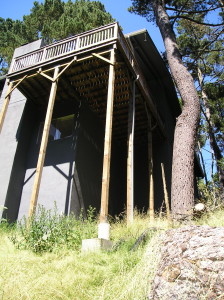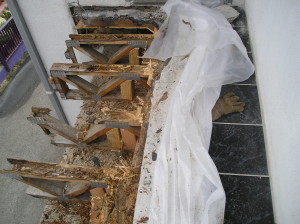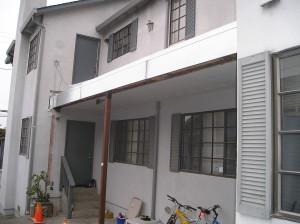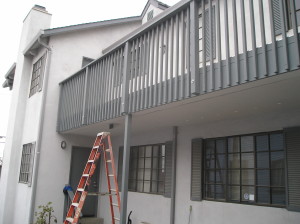Consolidated is a local family owned General contractor on the Monterey Peninsula.
CONSOLIDATED
box 588
Monterey, Ca. 93942
(831) 372-2803
Should I get 3 bids?
If a licensed Architect (not an un licensed designer) has drawn a full set of plans, details and specifications then it may be a good idea. If you do not have a full set of plans, details and specifications then you are getting bids on 3 different decks.
There are hundreds of ways to build a structure cheeper (cheeper quality and cheeper price). Labor rates are pretty constant on the monterey peninsula. Profit margins are also nearly all the same. Material prices are also the same. So, how can there be such a difference in the price of something as simple as a deck? The answer lies in using lesser materials and doing less labor.
One common failure is the ledger board. The ledger board is the wood frame that goes against the house. It secures the deck to the house and supports the decking above.
How can we reduce the installed cost of the ledger by 2/3?
First we could use a 2X6 rather than a 2X8, we could use #3 doug fir rather than #2 or better pressure treated to save on material cost. We could not back prime the ledger and not rubber seal the ends saving on the cost of paint, the cost of rubber sealer and also the labor to paint and rubber coat.( it’s on the back and no one will see it.) We could leave off the flashing saving sheet metal cost and the labor to form it and install it. We could attach it with a nail gun rather than bolts saving the cost of bolts, washers, nuts, labor to drill the holes and fasten the bolts. And that’s just the ledger board.
From the top the deck will look exactly the same but will last 60 weeks rather than 60 years. The difference is despite it’s appearance, it is not the same deck.
Then there is the argument “We build to code” Have you read the code? Look at the ninth word under purpose. The word is minimum. Minimum means the least way to build that is still legal.
In the years I’ve been doing this the most destructive thing has not been earthquake, wind or termites but water. The term dry rot is a misnomer. It comes from being wet. Rain, humidity and fog all contribute to the degradation of properties. The moisture acts as a catalist that accelerates processes like galvanic action, rust, termite proliferation fungus and mold.
Material science and engineering can improve the performance of structures and correspondingly the life expectancy of a property.
When it comes to structures the thing to remember is that the earth holds everything up.
So the obvious place to start is with soil mechanics and determining what type of soil we have. The following is a very brief overview of soil classification.
The unified soil classification system (USCS) established a procedure for classifying soil type. It establishes particle size distribution for granular soils using sieve analisys.
The USCS chart for major classifications are course: sand and gravel and fine is devided into coarse: if less than 50% passing thru #200 sieve the top chart is used. and fine: if more than 50% passing thru #200 sieve the bottom chart is used.
An alternate system is the ASHCE which uses 35%.
If the sample id course then the % of gravel and % of sand need to be determined by measuring the sand that passes thru sieve #4 to establish the sand fraction.
If the sieve #200 pass is 15% and the #4 sieve pass is 55% then there is 15% fine and 85% course. The sand fraction is 55-15=40% sand so gravel is 45% .
The fine portion is clay and silt. If the fine content is less than 5% the sample is low fine content. If fine is more than 12% it must be tested (in between is considered borderline soil)
The group symbols are S for sand G for gravel C for clay and M for silt. These make up the first letter of classification.
The particle size distribution is the second letter of the classification. These consist of W for well graded P for poor graded H for high plasticity and L for low plasticity.
Next is to determine the C sub u (uniformity coeficient) and C sub c (curvature coeficient)
For fine grain a hydrometer analisys test or a sedimentary test is used to determine the velocity that particles settle.
Next is to determine the Atterberg limits for plasticity index (PI)= LL (liquid limit)-PL (plastic limit).
Next is to determine the void ratio, perosity, water content and degree of saturation.
The results will give soil types as follows:
Gravels: GW GP GM GC
Sands: SW SP SM SC
Silts: ML MH
Clays: CL CH
Organic soils: OL OH
Peat: PT
So forinstance SWMH would be well graded sand and high plastic silt.




Leave a Reply